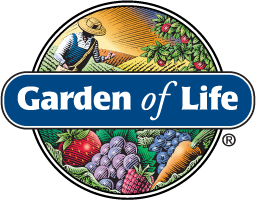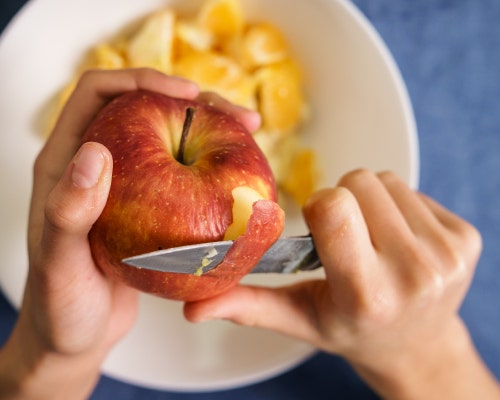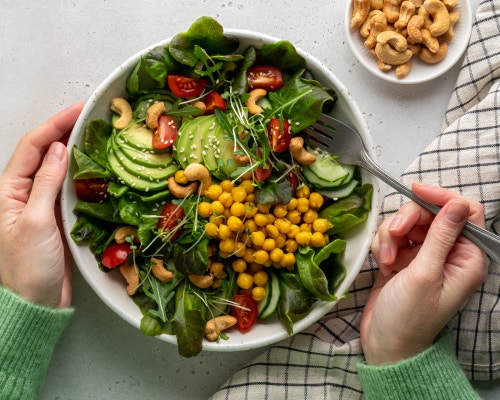The Plate Method: A Simple Guide to Planning a Perfect, Balanced Meal
- 9/25/23


One of the main tenets of good nutrition is balance. Eating too much or too little of any food can lead to nutritional imbalances or deficiencies. A well-balanced diet is the best way to ensure your body is getting the nutrients it needs.
The Dietary Guidelines for Americans have specific recommendations for how much of each macronutrient (carbs, proteins, fats) you should eat to achieve nutritional balance. These guidelines recommend that 10-35% of your calories come from protein, 45-65% from carbohydrates, and 20-35% from fat.
For most people, it can be challenging to translate these percentages into an actual meal. What does a balanced meal look like and how can you meet these macronutrient goals without a calculator?
What is the perfect meal?
A “perfect” meal is one that has balanced macronutrients, enough variety, and provides adequate calories. Don’t forget, it should also taste good!
The “plate method” is a great way to plan out a balanced meal. There are different versions of the ideal plate. The Dietary Guidelines for Americans version called MyPlate splits the plate into quarters. Each quarter has one food group: fruit, vegetables, grains, and protein, with dairy on the side.
The American Diabetes Association (ADA) slightly reduces the number of carbohydrates in the meal by splitting the plate in half. One half is filled with non-starchy vegetables, and the other half is split 50/50 between protein and high-quality carbohydrates, including fruit and whole grains.
As a dietitian, I do not think it is necessary to eat fruit at every meal, as is recommended by the MyPlate guidelines, therefore I lean more toward recommending the ADA plate. Choose which pattern works best for you, your preferences, and your eating style.
How to plan a perfect meal
Using the ADA plate method, here’s how you start designing a balanced meal.
Vegetables
Always start planning your meal by choosing your vegetables. Aim to make 50% of your plate vegetables. Vegetables are low in calories, high in fiber, and an incredible source of vitamins and minerals.
They can be served raw, cooked, roasted, steamed, or grilled. Select different colored veggies at each meal, such as green, red, orange/yellow, white, and purple. The more colors the better!
Protein
Next, pick your protein. The protein should take up around ¼ of the plate. Protein needs can vary based on the individual, but typically a good portion of protein is about the size of a deck of cards or the palm of your hand.
Good choices include lean chicken, fish, eggs, beans, legumes, or tofu. Vary your protein choices to include both animal and plant-based options.
High-quality carbohydrates
The next ¼ of your plate should include a high-quality carbohydrate. This may be a piece of fruit or a whole grain.
Similar to vegetables, try to select different fruits at each meal for the most variety. Avoid fruits that are dried, candied, or packed in a heavy syrup, as these are higher in sugar than fresh options. Good whole-grain choices include brown rice, quinoa, whole wheat bread, or oats.
Healthy fats
Finally, select a small portion of healthy fats to add to your meal. This may be in the form of olive oil used for cooking or drizzling, a few slices of avocado, or sliced nuts for an added crunch. Fat helps us feel full and can help make meals more satisfying.
Creating a balanced plate can be quite simple with the plate method and doesn’t require a calculator. When you start planning your meal with vegetables and partner them with protein, healthy fats, and high-quality carbs, you can achieve a balanced, nutrient-dense meal with little effort.
References:
-
Appendix E-3.1.A4. (n.d.). Retrieved June 26, 2023, from https://health.gov/our-work/nutrition-physical-activity/dietary-guidelines/previous-dietary-guidelines/2015/advisory-report/appendix-e-3/appendix-e-31a4
-
MyPlate. (n.d.). Retrieved June 26, 2023, from https://www.myplate.gov/
-
Eating Well. (n.d.). Retrieved June 26, 2023, from https://diabetes.org/healthy-living/recipes-nutrition/eating-well





